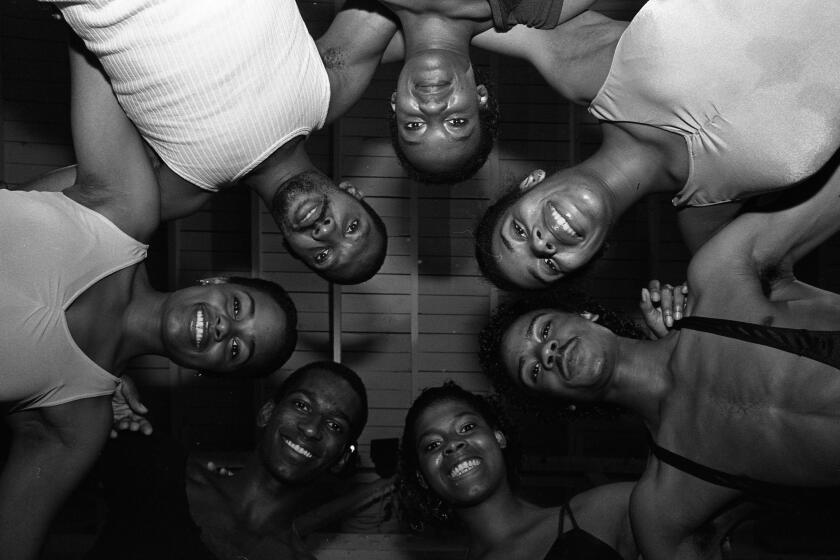The Black experience
This story originally ran in 1982 as part of the “Black L.A.: Looking at Diversity” series. We have preserved the original text in order to provide an accurate account of the work in print.
Being black in Los Angeles means seeking the best school that you can find for your children, hunting for an apartment or house that you can afford, making your way in business, going to parties on weekends or sitting home watching television — in short, doing the things that most people in Los Angeles do.
But the black experience in Los Angeles has an added dimension that too often sets it apart. Being black in Los Angeles also means encountering schools where too many teachers and students seem uninterested in learning, or the public does not care when they do. If you are a teen-ager, being black means a 50-50 chance of being unemployed.
Being black in Los Angeles also means trying to make your way in a white business world with few other blacks around for support, it means being the object of feeble jokes — or worse — by whites unused or unwilling to dealing with blacks. It means being rented to reluctantly or eyed suspiciously. It means turning on the television set and not seeing yourself represented.
In the summer of 1982, The Times published a series on Southern California’s Black community called “Black L.A.: Looking at Diversity.”
In short, it means racism.
In a recent series of articles, The Times’ black reporters have told this story of many dimensions. Through their polls and their interviews, the reporters found a wide range of black opinion. These were the most salient findings:
- Every day, nearly 13,600 black students voluntarily leave their neighborhoods by bus to attend what they or their parents consider better schools within the Los Angeles Unified School District. Another 6,600 blacks leave their neighborhoods to go to magnet schools for special studies. Yet another 15,000 go to parochial schools, 2,463 attend private schools and 1,000 go to black academies. Their choices underline what black parents think: Only 2% of those polled thought their children could get the best education in black schools, while 58% said that was possible in either white or integrated schools.
- Even so, young blacks have vastly greater chances to become doctors or engineers than to be professional athletes, yet they still choose — or are pushed onto — the football field or basketball court. Their studies suffer, and they can’t make the grade academically even if they can get college athletic scholarships. Too many colleges use them up athletically with little support scholastically or personally.
- While more than 60% of whites in Los Angeles have a favorable impression of the Los Angeles Police Department, only 45% of blacks share that feeling. More blacks react unfavorably about the police than favorably when polled, even though blacks want and need police protection because they are crime’s most likely victims.
- Large numbers of blacks argue that the media routinely distort the fabric of black life when they aren’t ignoring it altogether. Concentration on black crime and violence to the exclusion of portraits of interesting blacks will not change, they say, until more blacks are decision-making editors at local newspapers and television stations as well as national networks.
- And finally, blacks who range in age from 30 to 44—the generation that came of age during the civil-rights movement—make more money and have better prospects than ever, yet are more distrustful of whites and more pessimistic about the future than blacks older and younger.
Has there, then, been no change?
Blacks are no longer confined to teaching and preaching within the black community or to low-status jobs in the world at large. They range through corporate staffs and university faculties, but not near in proportion to their numbers in society. Good students have opportunities once closed to them. Black political leaders offer a prominent role model other than athlete or entertainer. The restrictive laws are gone, struck down by the courts and by decades of activism. And, most fundamentally, blacks and whites simply have more contacts now, in public spaces and businesses if not as often socially: acquaintanceship eases understanding.
But it remains an uneasy, distrustful relationship. Many blacks, for example, think that the white-controlled Los Angeles school board’s adamant opposition to busing is racism under another name. If there is a place to start to improve the lives of all blacks in Los Angeles, it is the public schools. Those schools cannot do their task without more support from the school board and money from the state Legislature.
Blacks also see some national leaders preach family values and yet seek to restrict money for family planning that would help ease the alarming rate of teen-age pregnancies, especially among blacks. They see a nation not creating enough jobs to give young black men self-respect and money in their pockets.
It remains a time for leadership in the schools, the police department, Congress, the White House — all places where such leadership is little evident today. Blatant Jim Crow racism is gone, but the problems still exist and, being more subtle, may be harder to solve. As black poet James Weldon Johnson wrote, the American racial dilemma “is not a static condition; rather it is, and always has been, a series of shifting interracial situations never precisely the same for any two generations.”
Race, like religion, has divided humanity for centuries. The efforts, by black and white together, to end that division can never be relaxed.
More to Read
Sign up for Essential California
The most important California stories and recommendations in your inbox every morning.
You may occasionally receive promotional content from the Los Angeles Times.










